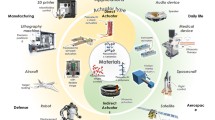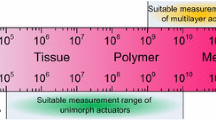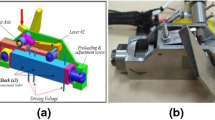Abstract
On the basis of classical piezoelectric theory, dielectric theory and anisotropic elasticity theory, a new design method designing generating actuation sensor based on the first positive and the secondary converse piezoelectric effect is presented according to the theory that first positive piezoelectric effect produces electric charges and the secondary converse piezoelectric effect produces micro-displacement to integrate sensors and actuators and to realize the small size, high precision and the same point control. The general design is introduced and then the mechanical structure and the preloading are described in detail through theoretical research and experimental verification, and validated. Results show that the output of sensor based on the first positive piezoelectric effect is good, and the actuator based on the secondary converse piezoelectric effect has an error with a maximum value of 0.058.
Access this chapter
Tax calculation will be finalised at checkout
Purchases are for personal use only
Similar content being viewed by others
References
Wu, Jiagang, and Dingquan **ao, Jianguo Zhu. 2015. Potassium–sodium niobate lead-free piezoelectric materials: past, present, and future of phase boundaries. Chemical Reviews 115: 2559–2595.
Reichmann, Klaus, Antonio Feteira, and Ming Li (2015) Bismuth sodium titanate based materials for piezoelectric actuators, Materials. 8: 8467–8495.
Lee, Junwoo, et al. (2014) A micro-fabricated force sensor using an all thin film piezoelectric active sensor. Sensors 14: 22199–22207.
Daraji, A.H., J.M. Hale, and J. Ye. 2018. New methodology for optimal placement of piezoelectric sensor/actuator pairs for active vibration control of flexible structures. Journal of Vibration and Acoustics. 140: 011015.
Przybylski, Jacek, and Grzegorz Gasiorski. 2018. Nonlinear vibrations of elastic beam with piezoelectric actuators. Journal of Sound and Vibration. 437: 150–165.
Morales, Allan Richmond R., and Mona E. Zaghloul. 2018. Highly sensitive wearable piezoelectric force sensor with quasi-static load testing. IEEE Sensors Journal 18.24: 9910–9918.
Catarino, Susana Oliveira, et al. 2014. Piezoelectric actuators for acoustic mixing in microfluidic devices—Numerical prediction and experimental validation of heat and mass transport. Sensors and Actuators B: Chemical 205: 206–214.
Wong, Yoke-Rung, Hejun Du, and **n Pang. 2015. Real-time electrical impedance resonance shift of piezoelectric sensor for detection of damage in honeycomb core sandwich structures. NDT and E International 76: 61–65.
Yanbo, Wei, Shi Li**, and Wei **%2C%20and%20Wei%20**wen.%202014.%20Research%20on%20micro-flow%20self-sensing%20actuators%20based%20on%20piezoelectric%20ceramic%20stack.%20Journal%20of%20Harbin%20Institute%20of%20Technology%20%28New%20Series%29%2021%3A%2099%E2%80%93103."> Google Scholar
Sappati, Kiran, and Sharmistha Bhadra. 2018. Piezoelectric polymer and paper substrates: A review. Sensors 18, 3605.
Shi, Li **, et al. 2014. Investigation on multi-piezoelectric effects from the first positive piezoelectric effect. Key Engineering Materials, Trans Tech Publications 609: 1398–1403.
Acknowledgements
This work is supported by the National Key Research and Development Projects(Grant No.2018YFC1200304)
Author information
Authors and Affiliations
Corresponding author
Editor information
Editors and Affiliations
Rights and permissions
Copyright information
© 2021 The Author(s), under exclusive license to Springer Nature Singapore Pte Ltd.
About this paper
Cite this paper
Du, C. et al. (2021). Generating Actuation Sensor Based on the First Positive and the Secondary Converse Piezoelectric Effect. In: Chang, JW., Yen, N., Hung, J.C. (eds) Frontier Computing. FC 2020. Lecture Notes in Electrical Engineering, vol 747. Springer, Singapore. https://doi.org/10.1007/978-981-16-0115-6_130
Download citation
DOI: https://doi.org/10.1007/978-981-16-0115-6_130
Published:
Publisher Name: Springer, Singapore
Print ISBN: 978-981-16-0114-9
Online ISBN: 978-981-16-0115-6
eBook Packages: Computer ScienceComputer Science (R0)




